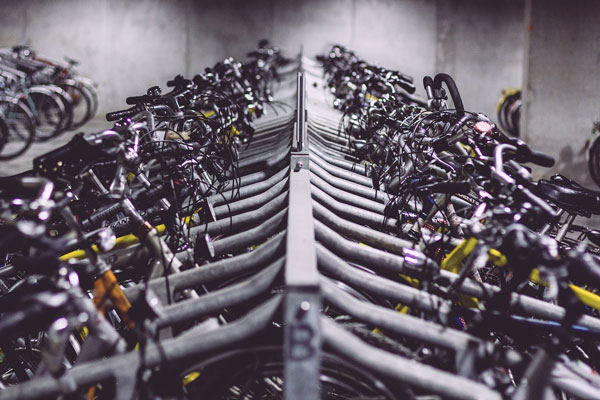
From affordable bike-share stations to spacious office showers, bicycling infrastructure is the key to creating more vibrant cycling communities.
Buildings and facilities equipped with bike-friendly features are not only more economically valuable, but they also promote healthier, happier building occupants.
That starts with the stress of a morning commute. According to Timothy Hamilton, a professor at the University of Richmond, neighborhoods with bike share stations in Washington, D.C. had 2 to 3 percent less traffic congestion than areas without them.
Bike infrastructure can also lead to increases in financial savings, physical health, emotional wellness and overall quality of life. “There are many benefits for the economy, public health and the environment,” says Tom Tilma, executive director of the Greater Grand Rapids Bicycle Coalition.
Bicycle infrastructure in buildings brings a number of rewards to everyone who lives and works there. But how can a building become more bike-friendly in a way that works for everyone?
To become part of the bicycle revolution and reap the financial, environmental and health rewards of foster a community of cyclists, follow these helpful tips for making your building more bike-friendly.
Getting Started with Bike-Friendly Infrastructure
First and foremost, it’s important to determine the greatest needs of your community. Are there bike-friendly roads leading up to your building? Do most people who live or work in your building already own bikes, or would they prefer a bike share? These types of questions will help you generate conversations around bicycling challenges and solutions at the facilities you manage.
This worked well in Pittsburgh, where mayor Bill Peduto conducted a city-wide survey on bicycling in late 2015. Peduto noted that conducting a study helped the city devise a stronger, more holistic plan for reducing automobile use.
“We need to study the best ways of structuring every means of transportation — be they streets, public transit, sidewalks or bike lanes — and these survey results will help put us on that path together,” he explained.
The Pittsburgh study found that 8.6% of all work commutes occur via bike. This kind of information is helpful for a facilities manager when devising a plan for a more bike-friendly facility.

Improving Access to Bike Share Programs
Bike shares promote affordable bicycling among people who may not own a bike, which may help some people transition from driving a car to cycling more often.
Bike shares can also make communities safer. Holly Houser, executive director of Puget Sound Bike Share in Seattle, notes that “bike sharing stations help to create and enhance communities of people, which in turn, increases safety in neighborhoods.” The popularity of bike shares among communities is proven in a recent national study on urban biking, which found that Minneapolis residents chose bike shares over car trips almost 20 percent of the time.
Because bike shares offer so many benefits, many cities across the nation have begun to see them as a necessity, rather than a nice-to-have. As Bill Dossett, executive director of the Twin Cities’ bike share program, Nice Ride Minnesota, explains: “It’s no longer a novelty. To be a world class city, you need to have a bike share program.”
If your city does have its own bike share program, here are three steps you can take right now to get more building occupants pedaling to work:
- Add bike parking spaces to your own building (if they aren’t there already).
- Offer incentives to employees who commute by bike.
- Offer discounts on bike memberships to increase usage at your building.
Small-Fleet Bike Sharing
Despite the benefits of city-wide bike share programs, they can be expensive for smaller facilities. If bike shares aren’t possible at your building, there’s still another option: private companies like Zagster deploy affordable bike fleets specifically designed for smaller communities.
In fact, Zagster’s business model was born out of the idea of making buildings more bike-friendly. As CEO Timothy Erikson tells Bikeshare: “We found that we were being approached by apartment complexes, hotels, and universities who all said, ‘We love the idea of bike share, but we don’t want to pay the expensive price tag of Bixi and B-cycle’s product.’”

Affordable Bike Infrastructure in Your Building
As more cities and communities implement bike share programs, they discover that the programs need to harmonize with existing infrastructure in order to work. As walkability expert and urban planner Jeff Speck suggests, “It’s only when bicycles are coupled with safe and more ubiquitous biking facilities that bike share is likely to get a large following.”
On-Site Bike Maintenance
Offering repair areas in your building welcomes cyclists and helps them become more confident in the case of a breakdown. Candace Jackson at The Wall Street Journal had an example of what this might look like in a piece on a new apartment complex in Minneapolis called Vélo North Loop. Here, she says “tenants can use the ‘bike kitchen’ — a bicycle repair area with tire pumps and spare chain links, as well as a bike wash.”
If you don’t have space for an entire repair room, consider placing a few bike repair items in a nearby closet. A bike pump, a toolbox and a few spare tubes can be extremely helpful for a commuter in need of a repair. You also might consider workshops, like those implemented in Toronto. This city provides its employees with “bicycle procurement assistance, safety training, and maintenance for a pool of City bicycles” to encourage bicycle commuters.
Such programs have also been praised by Suzanne Schulz, an urban planning director in Grand Rapids. Schulz implements education and training programs to help people become safer, more proficient riders. “There may be workshops on how to fix your bike, how do you ride on a busy street. There are multiple avenues to raise awareness and build this culture of people respecting each other within the right-of-way.”
Financial Incentives and Member Perks
Another way to make bicycling more accessible is to make it more enjoyable. For example, showers and changing rooms can make bicyclists more willing to bike to work. At the SRAM office in Chicago, showers and changing rooms have been enhanced to accommodate an influx of people during the busy morning commute hours.
As David Zimberoff, SRAM’s director of marketing, tells Slate: “What we did was we super-sized everything to remove those barriers. There are full-sized lockers, towel service, a washer and dryer and six showers — so there’s never a wait.”
Some companies have been known to include financial perks for employees who bike to work. At the Clif Bar headquarters in California, employees are given a $500 stipend to buy or repair a bike. Clif Bar CEO Kevin Cleary describes this as an essential part of the company’s culture, and he even squeezes in bike rides during the work day. "It's a good example for me to set for people at the company,” he says.
Another company the adopts the giving spirit is Honest Tea. CEO Seth Goldman says that he donated bikes to his employees after the company sold its billionth beverage. “We talked about how we could really thank our employees in a way that felt true to our brand and what we stand for,” Goldman writes at Inc. After tossing out different options, we chose the one that seemed the most us — we purchased bikes for all employees who wanted them (and most took us up on it).”
If donating bikes is out of your budget, consider loaning them: Bonneville Power Authority in Portland offers loaner bikes and tools for commuters in need. “If your day entails working offsite, borrow a loaner bike if you didn't ride that day,” writes Oregon Live culture reporter David Stabler. “On the way home, make quick repairs with a bike stand, a patch kit for flats and a set of loaner tools.”
Indoor and Outdoor Storage
Bike racks are pretty much a staple at most public buildings, but many people don’t realize the lasting impact of adding just a few more. As demonstrated in the city of Grand Rapids, the addition of 39 new bike racks improved bike parking by 12 percent overall.
Bike racks also send a subtle message to cyclists, encouraging them to ride more often. Jim Talen, Kent County Commissioner and chairman of the DDA’s Environment Action Group, tells Michigan Live that bike racks “become more and more important for attracting people to use these modes of transportation. We really need them more places to make them closer (to where people want to go).”
Grand Rapids’ bike advancements are also well-received by Aaron Smith, a Grand Rapids attorney and avid cyclist. “Owners of buildings don’t want bikes in the lobby,” he adds. “They need to have a place that’s safe and convenient so they [commuters] can park it there.”
And when building owners are planning to add safe, convenient bike racks, there is a science to getting it right. Andy Clarke, Director of Strategy at Toole Design Group, notes that builders need to pay special attention to the location of both indoor and outdoor bike racks.
“If the parking racks aren’t placed in the right spot, meaning convenient, easy to access and use, and near the entrance to the destination, the cyclists will simply park their bikes where they want, somewhere close and able to handle a lock,” he tells The Park Catalog.
Creating a more bike-friendly facility isn’t an overnight task, but it is a highly rewarding one that will benefit your building and its occupants for years to come.
Credits:
UnsplashStockSnap

